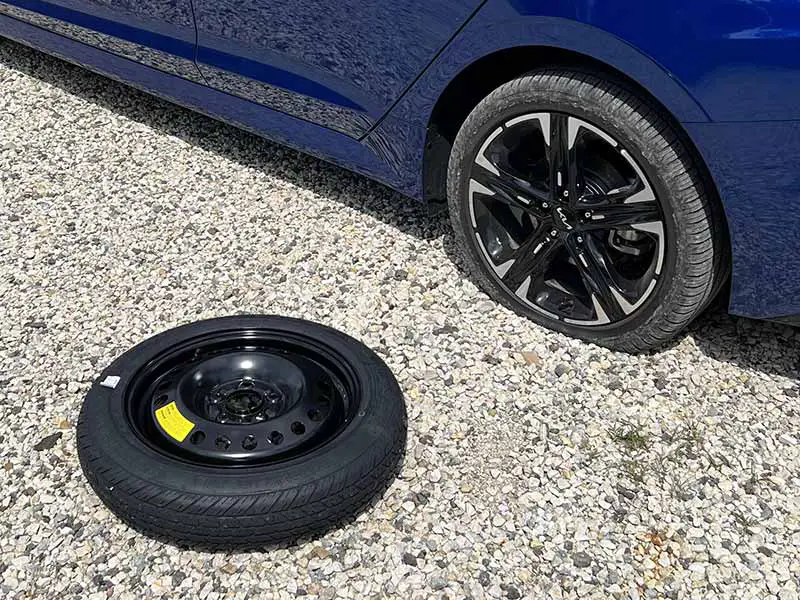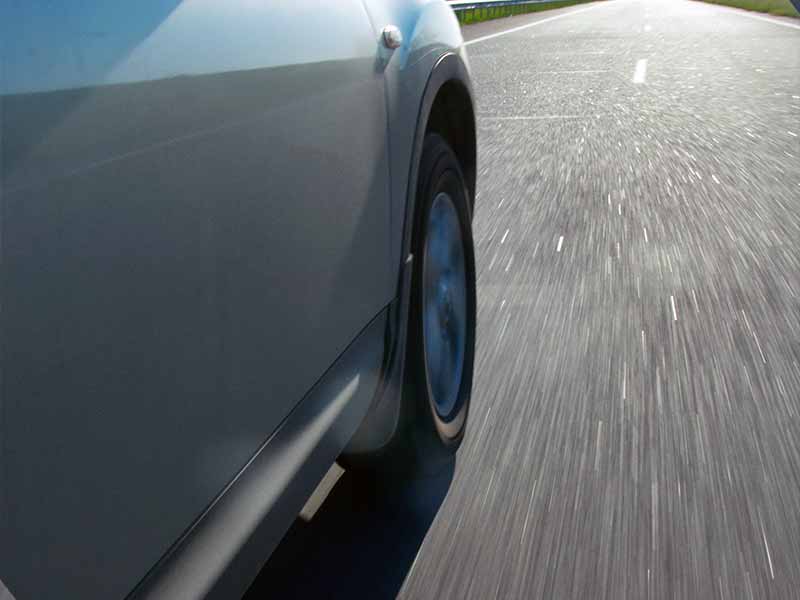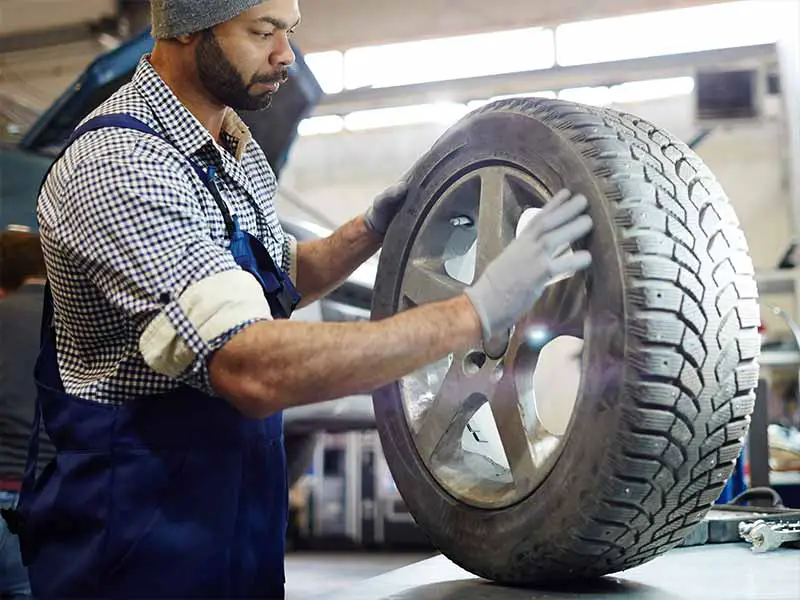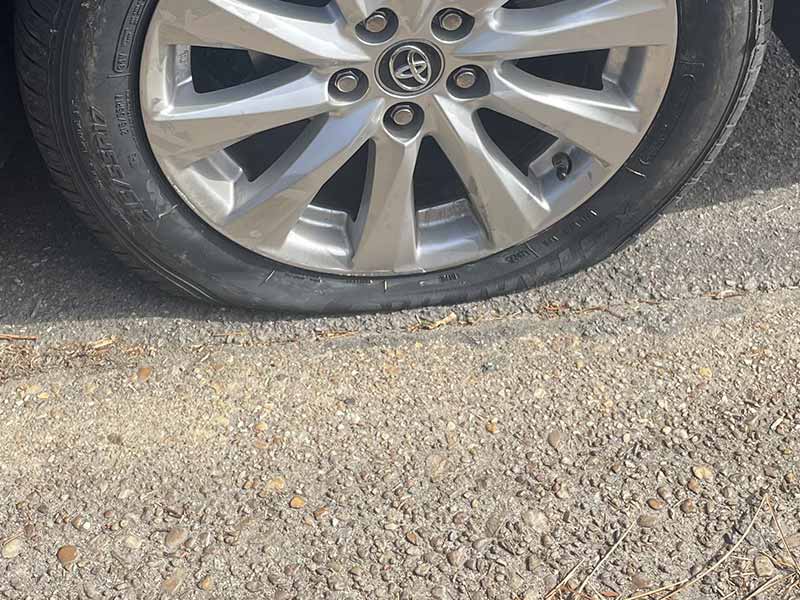Flat spots are a common issue if their vehicle has been parked for an extended period. Not all flat-spotting will is temporary.
If you’re experiencing a bumping noise and you don’t have a smooth ride after leaving your car parked overnight in cold ambient temperatures or for long-term parking, keep reading to learn what to do.
Will A Flat Spot On A Tire Correct Itself?
A flat spot on a tire can sometimes correct itself, particularly if it’s a temporary flat spot caused by extended parking or storage.
However, permanent flat spots due to damage or long-term storage may require professional assessment and possible tire replacement.
In this article, we’ll explore the ins and outs of flat spots, including what causes them, how to recognize the symptoms, and most importantly, if they can correct themselves.
Let’s take a closer look.

If A Tire Sits Too Long, It Can Damage The Structural Integrity Of The Tire Itself
What Causes Flat Spots On Tires?
Flat spots on tires happen when a part of the tire gets squished or pressed against the ground for a long time. Think of it like sitting on a soft cushion for a while – when you stand up, there’s an indent where you were sitting. The same thing can happen to tires.
Let’s look at some common reasons why tires get flat spots:
Long-Term Parking Or Storage
When a car or truck sits in one place for a long time, the tires can develop flat spots. The weight of the vehicle presses down on the tires, causing them to lose their round shape. This can happen in parking lots, garages, or even on the street.
Cold Weather
When it gets really cold outside, your tires can become stiff and hard. If your vehicle is parked outside in cold temperatures, the tires can develop flat spots more easily. The rubber doesn’t bounce back as quickly when it’s cold, so it’s important to check your tires if you live in a chilly place.

How To Get Rid Of Flat Spots On Tires From Sitting
Don’t worry if your tires have flat spots from sitting too long. There are some simple things you can do to help your tires get back to their round shape.
Here are a few suggestions:
Drive The Vehicle
Sometimes, all you need to do is take your car or truck for a drive. As you drive, the tires will warm up and start to become more flexible. This can help the flat spots smooth out. It might take a few miles for the flat spots to go away, so be patient.
Tire Massage Technique
This might sound funny, but you can actually massage your tires to help them regain their round shape. Use your hands to gently press on the flat spot, working the rubber back and forth. This can help the tire become more flexible and get rid of the flat-spotting. Just make sure you’re careful not to hurt your hands on any sharp edges.
Inflate The Tires
Sometimes, flat spots happen because your tires aren’t inflated enough. Check the air pressure in your tires and make sure it’s at the right level. You can find the correct tire pressure for your car or truck in the owner’s manual or on a sticker inside the driver’s door. If the tires need air, fill them up to the recommended pressure. This can help get rid of flat spots and make your tires last longer.

Flat Spot On Tire Symptoms
If you think your tires might have flat spots, there are a few signs you can look for. Keep an eye (and ear) out for these issues while you’re driving:
Vibration While Driving
When your tires have flat spots, they might not roll smoothly on the road. This can cause your car or truck to vibrate or shake while you’re driving. If you feel vibrations in your steering wheel, seat, or floor, it could be a sign that you have flat spots on your tires.
Unusual Tire Noise
Flat spots can make your tires create strange noises when you drive. You might hear a thumping, bumping, or even a humming sound. If you notice any weird noises coming from your tires, it’s a good idea to check for flat spots.
Uneven Tire Wear
If your tires have flat spots, they might wear down unevenly. This means that some parts of the tire will wear out faster than others. You can check for uneven wear by looking at the tread (the grooves on the tire that help grip the road). If you see that some parts of the tread are worn down more than others, it could be a sign of flat spots.
If you notice any of these symptoms while driving, it’s important to check your tires for flat spots. Flat spots can be a safety issue and might make your car or truck harder to control.

Is It Safe To Drive On A Tire With A Flat Spot?
Driving with a flat spot on your tire can be a bit tricky. Whether it’s safe or not depends on how bad the tire’s flat spotting is and how it affects your driving.
Here are some things to consider when deciding if it’s safe to drive on your flat-spotted tire:
How bad is the flat spot?
If the flat spot is small and doesn’t cause too much vibration or noise, it might be okay to drive for a short distance. But if the flat spot is really big or makes your car shake a lot, it’s better to be safe and get it fixed before driving.
How does it affect your driving?
If you can still control your car or truck well and don’t have trouble steering, braking, or accelerating, it might be safe to drive with a flat spot. But if the flat-spotting makes it hard to control your vehicle, it’s best to get the tire fixed before hitting the road.
Temporary or permanent flat spot?
Some flat spots are temporary and can go away on their own after you drive for a while. If you have a temporary flat spotting, it might be safe to drive as long as it doesn’t cause too much trouble. But if it’s permanent and won’t go away, it’s important to get your tire fixed or replaced before driving.
In general, it’s always best to be cautious when it comes to driving with flat spots. If you’re not sure if it’s safe, it’s a good idea to ask a professional for help. They can take a look at your tire and let you know what to do.

How Long Can Tires Sit Before They Get A Flat Spot?
The truth is, there’s no one-size-fits-all answer to how long it takes for flat spots to form. How long it takes depends on a few different factors, like:
Tire Type
Different tires are made from different materials, and some are more likely to get flat spots than others. For example, high-performance tires or tires made from softer rubber might develop flat spots more quickly than regular passenger car tires.
Tire Pressure
If your tires are properly inflated, they’ll be less likely to get flat spots when sitting for a long time. Make sure to check your tire pressure regularly and keep it at the recommended level.
Weather
Cold weather can make tires more likely to develop flat spots. If it’s really cold outside, your tires might get flat spots more quickly than if it’s warm.
Vehicle Weight
Heavier cars and trucks can cause more pressure on the tires, which can lead to flat spots. If you have a heavy vehicle, it’s especially important to take care of your tires and prevent flat spots from forming.
In general, it can take anywhere from a few days to a few weeks for tires to develop flat spots if a car or truck is parked without moving. To be on the safe side, it’s best to move your vehicle every once in a while to help prevent flat spots from forming.

Tire Cradles Are Often Used To Help Prevent Flat Spots During Extended Vehicle Storage
How To Prevent Flat Spots On Tires During Storage
If you know you’ll be storing your car or truck for a while, you should consider taking these steps to prevent flat spots from forming.
Here are some helpful tips to keep your tires in great shape during storage:
Proper Tire Inflation
Before you store your vehicle, make sure your tires are inflated to the recommended pressure. This can help keep them round and reduce the chance of flat spots. Check the owner’s manual or the sticker inside the driver’s door to find the right pressure for your tires.
Tire Storage Covers And Bags
Protecting your tires from dirt, dust, and sunlight can help prevent flat spots. You can buy special tire covers or bags to put over your tires while they’re in storage. These covers can also help protect your tires from damage caused by changes in temperature or humidity.
Tire Cradles And Dollies
Another way to prevent flat spots is to use tire cradles or dollies. These are special supports that you place under your tires to help distribute the weight of your vehicle more evenly. Tire cradles and dollies can help prevent flat spots by keeping your tires off the ground and reducing the pressure on them.
Rotating The Tires Periodically
If you can, try to move your car or truck a little bit every few weeks while it’s in storage. This can help prevent flat spots by shifting the weight on your tires and allowing them to keep their round shape.

Craftsman V20 Inflator – Portable Air Compressor
Can A Flat Spot On A Tire Correct Itself?
Sometimes, tire flat spotting can actually correct itself. But this depends on a few things, like how bad the flat spotting is and what caused it in the first place.
Here’s what you need to know:
Temporary Flat Spots
If your tire has temporary flat spotting, it might go away on its own after you drive for a while. When you drive, the tires warm up and become more flexible. This can help smooth out the flat spot and get it back to its round shape.
Permanent Flat Spots
If your tire has a permanent flat spot, it won’t fix itself. Permanent flat spots can happen if your tire is damaged or if it has been sitting for a really long time. In this case, it’s best to get your tire checked by a professional. They can help you figure out if it’s safe to keep using the tire or if you need to replace it.
Resources
Below are some links you may find helpful when learning about tires
Final Thoughts
We’ve learned about tire flat spotting, what causes it, how to recognize the symptoms, and even ways to fix it. Remember, some flat spots can correct themselves, while others may be too badly damaged, and you’ll need to buy a new tire.
By understanding flat spots and how to prevent them, you’re not only taking care of your tires but also making sure you and your passengers stay safe on the road.
Good luck and happy motoring.





